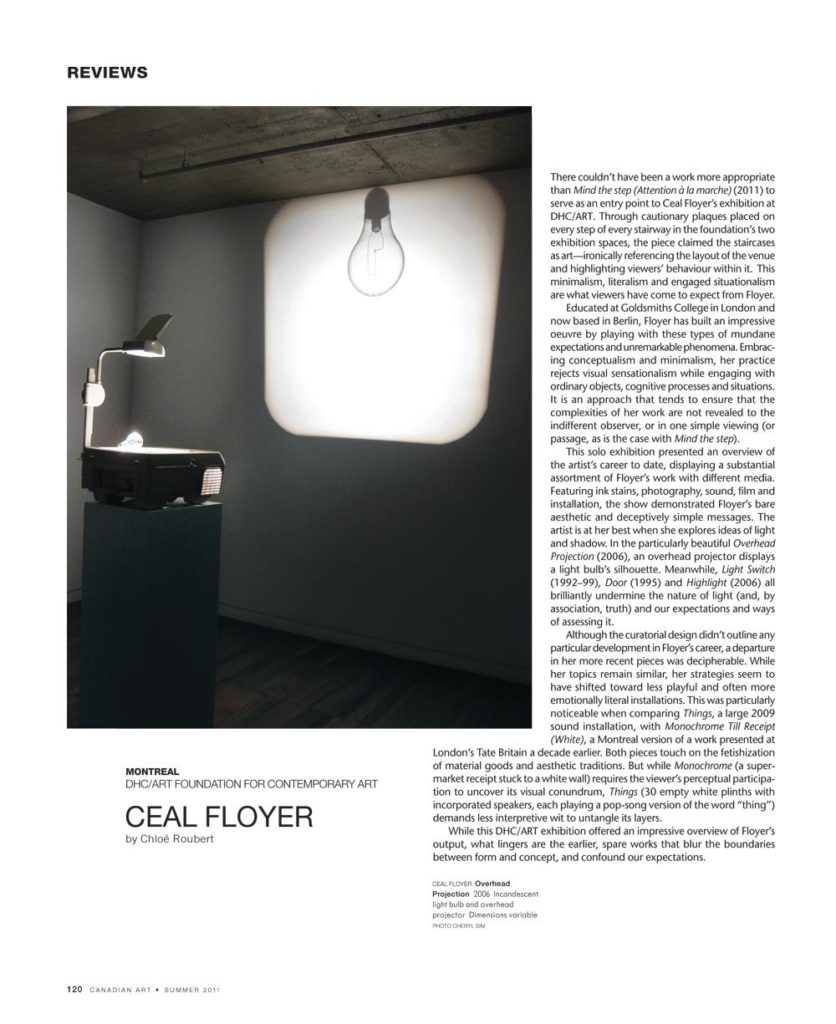There couldn’t have been a work more appropriate than Mind the step (Attention à la marche) (2011) to serve as an entry point to Ceal Floyer’s exhibition at DHC/ART. Through cautionary plaques placed on every step of every stairway in the foundation’s two exhibition spaces, the piece claimed the staircases as art—ironically referencing the layout of the venue and highlighting viewers’ behaviour within it. This minimalism, literalism and engaged situationalism are what viewers have come to expect from Floyer.
Educated at Goldsmiths College in London and now based in Berlin, Floyer has built an impressive oeuvre by playing with these types of mundane expectations and unremarkable phenomena. Embracing conceptualism and minimalism, her practice rejects visual sensationalism while engaging with ordinary objects, cognitive processes and situations. It is an approach that tends to ensure that the complexities of her work are not revealed to the indifferent observer, or in one simple viewing (or passage, as is the case with Mind the step).
This solo exhibition presented an overview of the artist’s career to date, displaying a substantial assortment of Floyer’s work with different media.Featuring ink stains, photography, sound, film and installation, the show demonstrated Floyer’s bare aesthetic and deceptively simple messages. The artist is at her best when she explores ideas of light and shadow. In the particularly beautiful Overhead Projection (2006), an overhead projector displays a light bulb’s silhouette. Meanwhile, Light Switch (1992–99), Door (1995) and Highlight (2006) all brilliantly undermine the nature of light (and, by association, truth) and our expectations and ways of assessing it.
Although the curatorial design didn’t outline any particular development in Floyer’s career, a departure in her more recent pieces was decipherable. While her topics remain similar, her strategies seem to have shifted toward less playful and often more emotionally literal installations. This was particularly noticeable when comparing Things, a large 2009 sound installation, with Monochrome Till Receipt (White), a Montreal version of a work presented at London’s Tate Britain a decade earlier. Both pieces touch on the fetishization of material goods and aesthetic traditions. But while Monochrome (a supermarket receipt stuck to a white wall) requires the viewer’s perceptual participation to uncover its visual conundrum, Things (30 empty white plinths with incorporated speakers, each playing a pop-song version of the word “thing”) demands less interpretive wit to untangle its layers.
While this DHC/ART exhibition offered an impressive overview of Floyer’s output, what lingers are the earlier, spare works that blur the boundaries between form and concept, and confound our expectations.
This is an article from the Summer 2011 issue of Canadian Art. To read more from this issue, please visit its table of contents.

 Spread from the Summer 2011 issue of Canadian Art
Spread from the Summer 2011 issue of Canadian Art







